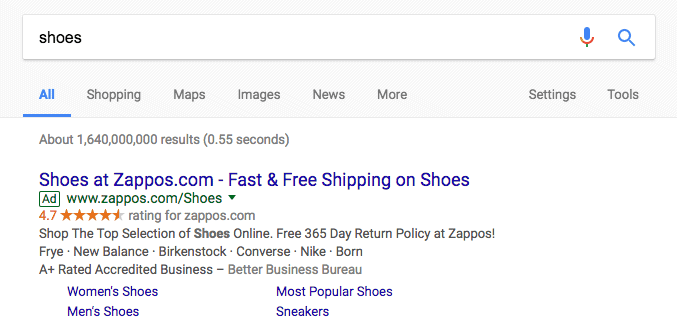What's in this article?
Google has made another small (but not so small) adjustment. This time it’s AdWords paid search label. It’s a change that could affect SEO, content marketing, and paid search marketing practices in a big way.
All the fuss is over a little green box on the second line of Google Search Ad paid search results. The box was green with white lettering. Now it’s a thin green outline of a box with green lettering. I know this sounds minuscule, but this tiny change is likely to shake up the digital marketing world in several important ways. Here’s how.
UX Friendly, Less Intrusive Ads
On the first impression, seamless UX comes to mind. Google has said an “easier to read” page was one goal. Another is to streamline the color palette. This ad label fits in with surrounding content, including the neighboring organic SERPs.
Google appears to be moving toward blurring the line between paid and organic. There’s sometimes this idea that all ads are a distraction to the user, but that’s not the case. Irrelevant, annoying ads are a distraction to the user. Search ads are appreciated by search users — when they’re relevant.
Mobile First or Bust
Search Engine Watch points out that changes like this don’t happen in a vacuum. One interpretation is that the change is part of a full-steam-ahead approach to the mobile-first web. The simplified color palette fits with that idea. So do other recent Google moves — expanded text ads, the end of right-hand sidebar ads.
Any Change Is Good Change
Another interpretation is that any change is a good change. Change gets noticed, even if it’s a small one. And with ads, change that gets noticed may also get clicked. That’s more revenue for Google and more click-through for advertisers.
It’s easy to forget, but the ad label has now gone through four changes in the past two years. Remember when it was an earthy yellow? The change from yellow to green reportedly had a big effect on relative CTR. So partially, the change could just be to change things up and get another round of boosted ad performance for all.
Is the Future in Paid Search?
Another thought is that the clear direction toward subtle ad labeling is about more than just the next quarter’s performance. Some marketers worry this could be another nail in the coffin for organic search marketing. The question is: is paid search the future?
Search Engine Watch seems to think so — but with a caveat. The future of paid search may be more like today’s organic search. That is, the best performers and even the big winners for paid search may not be whoever has the biggest budget. It may be who has the best SEO for their paid ads.
That still leaves organic SEO marketers and brands in a more delicate position. Less obviously labeled ads stand to get more clicks, especially if they’re more relevant to the user’s search. Organic SERPs further down the page may suffer, especially in a mobile-first world where most of the organic SERPs are “below the fold.”
Another caveat, the future of this tiny label change and its many possible implications is still speculative. Google is notoriously tight-lipped about unrevealed plans. For marketers and brands, the next step is watchful waiting. Keep an eye on both your paid and organic CTRs to see what if any adjustments your team should make.
